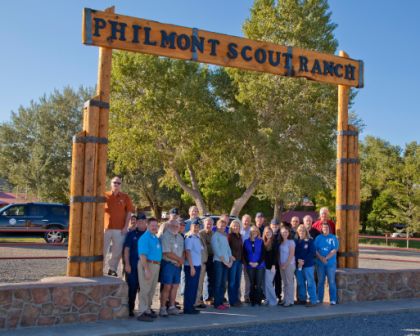

Now That We Have One, What Do We Do With It?
Article by: Duke Stevens, District 8-CR Vessel Examination Officer, San Antonio, TX
Photo by: Bryan Hayek, Marketing Manager, Boy Scouts of America
Philmont Scout Ranch, Marketing and Web Operations
 |
|
First Annual Boy Scouts of America Partnership Summit held at the National Scout Ranch in Philmont, New Mexico. |
That is the question which was being asked by 26 people representing 13 different organizations last month at the First Annual Boy Scouts of America Partnership Summit held at the National Scout Ranch in Philmont, New Mexico.
The question was directed at the Memorandums of Agreement (MOA’s) or the Memorandums of Understanding (MOU’s) which each of the organizations represented at the Summit have with the Boy Scouts of America (BSA). Over the course of the three day event participants discussed both problems and possible solutions on how to make a working document increase their relationship with the BSA, as well as with the other organizations which have similar MOA’s or MOU’s.
The USCG Auxiliary was represented by a four person team comprised of Commodore Nick Tarlson (D11-NR), Branch Chief of the Youth Programs Department, Charles Evans (D13), Public Education Instructor, Duke Stevens (D8-CR), District Vessel Examiner Officer , and Amy McNeil (D8-WR), a new member of the Auxiliary with an extensive background in working with the BSA.
The other organizations attending the conference included the U.S. Army Corps of Engineers, the U.S. Power Squadron, Professional Association of Diving Instructors (PADI), American Hiking Society, U.S. Orienteering, American Heritage Girls, U.S. Sportsman Alliance, U.S. Forest Service, Trout Unlimited, the National Wild Turkey Federation, Tread Lightly!, and naturally, the BSA. The geographic makeup of the Summit attendees represented 14 States which cover coast to coast and border to border.
In accordance with the MOA between the Auxiliary and the BSA executed in 2009, the Coast Guard Auxiliary agreed to work together to promote recreational boating safety, citizenship training and character development. The Auxiliary agreed to provide public education classes and vessel safety checks to all Scouts and it has the authority to provide operational training to Sea Scouts, a coed program offered by the BSA to young adults 14 years (or 13 years and completed the eighth grade) through the age of 21.
Due to safety concerns, strict guidelines are in place limiting the number of Sea Scouts which can be on an Operational Facility (OPFAC) at any time, the type of equipment they must be issued, and restrictions on their involvement in direct operations.
Additionally, the Auxiliary is authorized to provide shore side and underway training on many of the dockside tasks found in the Auxiliary Boat Crew Training Manual. More information about the Sea Scouts program can be found at auxbdeptwiki.cgaux.org
“On behalf of the Boy Scouts of America, thank you very much for making the effort to travel to New Mexico for the workshop. I believe we made great strides in building a stronger bridge between the BSA and the organizations in attendance,” said Frank Reigelman, Director of Outdoor Programs, Boy Scouts of America.
~GJA 10-28-11